
Effectively managing a region’s roadways has increasingly become a difficult challenge. Construction demands, environmental concerns as well as easing overall traffic flow for allowing commerce to thrive are not simple tasks. In order to make the most impactful decisions, transportation planners need to not only understand traffic and the types of vehicles using their roads — they need to know how vehicles use them.
Going beyond simple location-based data is necessary when it comes to vehicle behavior. It is not enough to simply know when and where vehicles are anymore. Planners require deeper insight to understand the purpose of vehicle trips and popular routes. It is this level of analysis that Altitude’s Origin & Destination product provides. It digs deep into commercial traffic activity to uncover the context behind aggregate vehicle trips and understand vehicle journeys.
Trips 101 – What is a trip?

A trip is the act of a vehicle traveling from one place to another, that is, a nearly continuous drive where the operator remains within the vehicle from an origin to a destination. From an implementation perspective in the Altitude platform, a trip is an intelligent aggregation and statistical description of raw GPS points.
Altitude by Geotab defines a trip when a vehicle ignition has turned on and off or has idled for 200 seconds. However, this can be misleading in some instances. For example, a long-haul truck may make many stops along the way for refueling or rest periods and each stop could be construed as a new trip. Altitude’s Origin & Destination product is able to effectively filter out these types of small stops using a minimum stop duration threshold to chain together all trips to build an accurate vehicle journey, from its origin to its planned final destination.
Trip data sources
Trips in Altitude are generated using raw GPS points collected from a Geotab telematics device or provided directly from the vehicle manufacturer. Those GPS points are then transformed using Geotab’s patented curve logging algorithm. The curve logging algorithm compresses the device’s collected data points, discarding probable data points and instead focusing only on keeping data points that most accurately represent the vehicle’s true state. In short, curve logging is a reliable and efficient compression algorithm. The curve logging algorithm retains the most detailed telematics data with the least amount of data overhead.
Ultimately, incoming GPS points are used to construct trips for vehicles and to provide critical information about these trips such as the start/stop locations and times, trip distances and durations as well as pre- and post- idling information. By analyzing the stops and applying a user-defined stop duration threshold, trips are chained together for deeper insight into the vehicle’s journey.

Breaking down the trips algorithm
The trip construction algorithm consists of three stages:
- Stage 1 – Filtering for relevant GPS points.
- Stage 2 – Labeling GPS events based on vehicle movement and engine status.
- Stage 3 – Defining trips based on GPS events, and calculating statistics for each trip based on GPS points.
The diagram below shows a detailed example of how a trip is constructed from raw GPS points, where the x-axis represents a particular point in time.
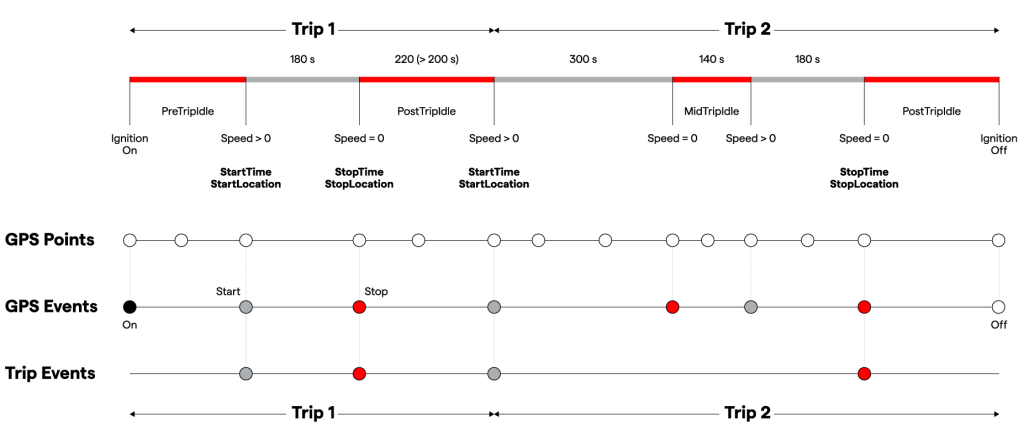
Transforming GPS points -> GPS events -> Trip events. Only some points are filtered through the next stage. In particular, though there may be several start and stop GPS events (see MidTripIdle in Trip 2), only a few qualify as start and stop trip events.
There are three stages to building a trip:
Stage 1 – Filtering GPS points
At this stage, the raw GPS data is filtered down to only those that are relevant for building trips. This filtered data also will include information such as speed, ignition status and geolocation information.
This crucial step filters through the massive amounts of GPS data points to only keep meaningful data points. The resulting data includes information about the vehicle’s previous and next data points. Interpreting each data point requires the context of earlier and later GPS points.
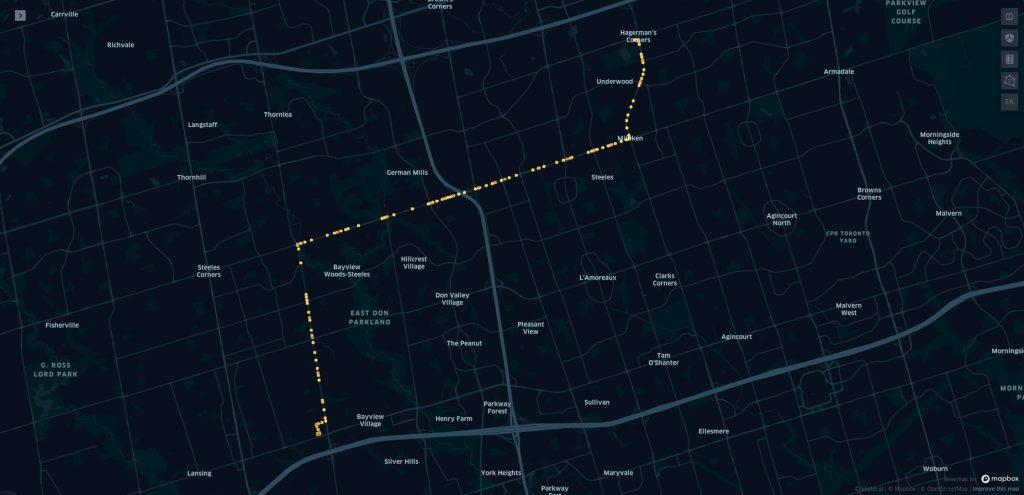
Stage 2 – Labeling GPS events
At this stage, GPS events are classified based on a specific point in time.
A GPS event is an intelligent labeling of a GPS point based on the context of earlier and later GPS points. There are only four possible GPS events, each identifying a state of the vehicle’s movement or engine:
- On: The engine is currently running and was not running in the immediately preceding time point.
- Start: The vehicle is currently moving and was not moving in the immediately preceding time point.
- Stop: The vehicle is no longer moving and was moving in the immediately preceding time point.
- Off: The engine is no longer running and was running in the immediately preceding time point.
This stage also includes a comprehensive yet efficient handling of a wide variety of edge cases, including GPS signal loss and unreliable ignition signals.
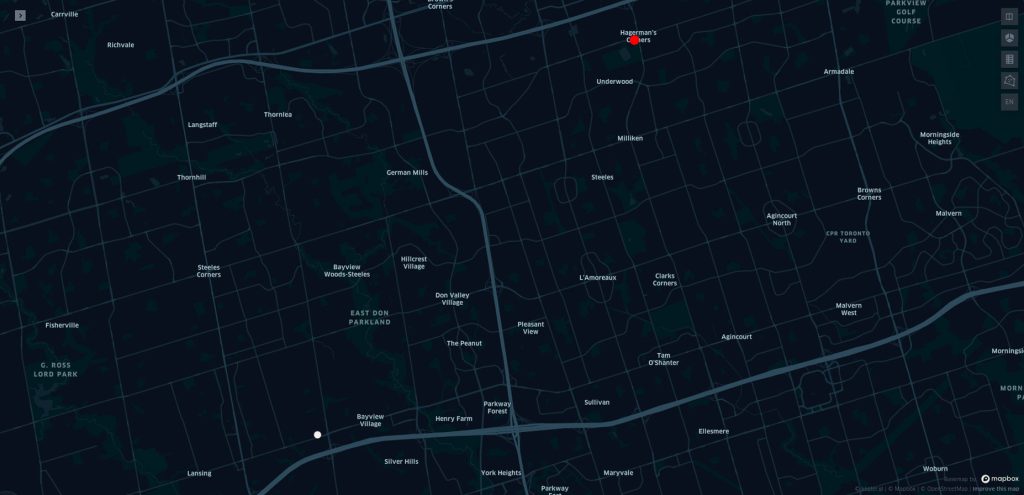
On (in red) and Off (in white) Location
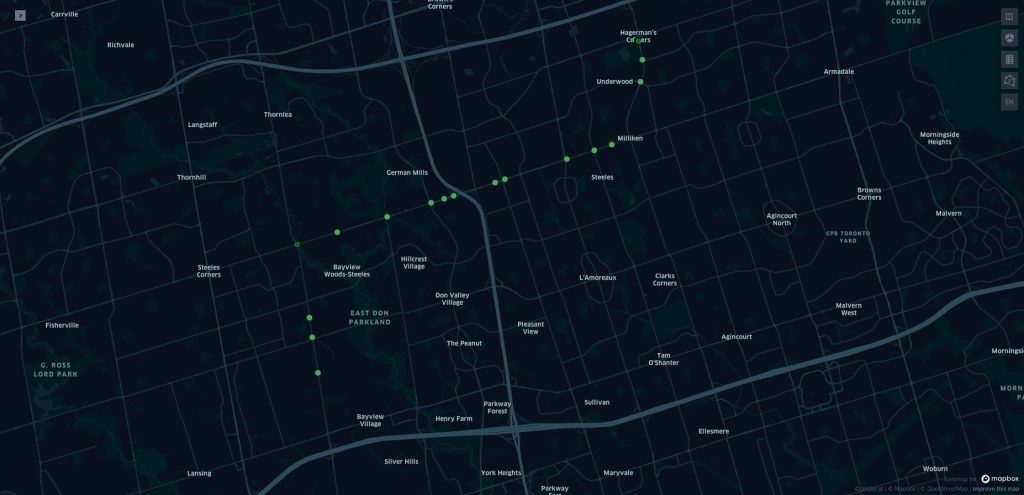
Start GPS events. Note that there are many GPS points that do not qualify as GPS events.
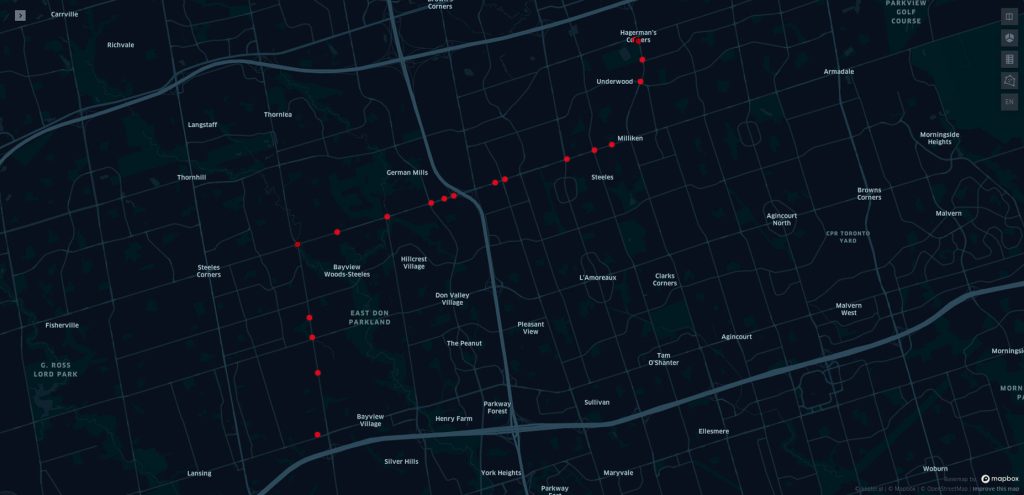
On/Off and Stop GPS events – there are overlaps between start GPS and stop GPS points.
Stage 3 – Defining trips
At this stage, trips are defined by identifying which pair of Start and Stop “GPS events” should qualify as the Start and Stop “trip events”. Each pair of Start and Stop trip events then define a distinct trip. In this stage, important data is gathered such as start and stop location, start and stop times, trip duration, distances, as well as pre- and post- idling information.
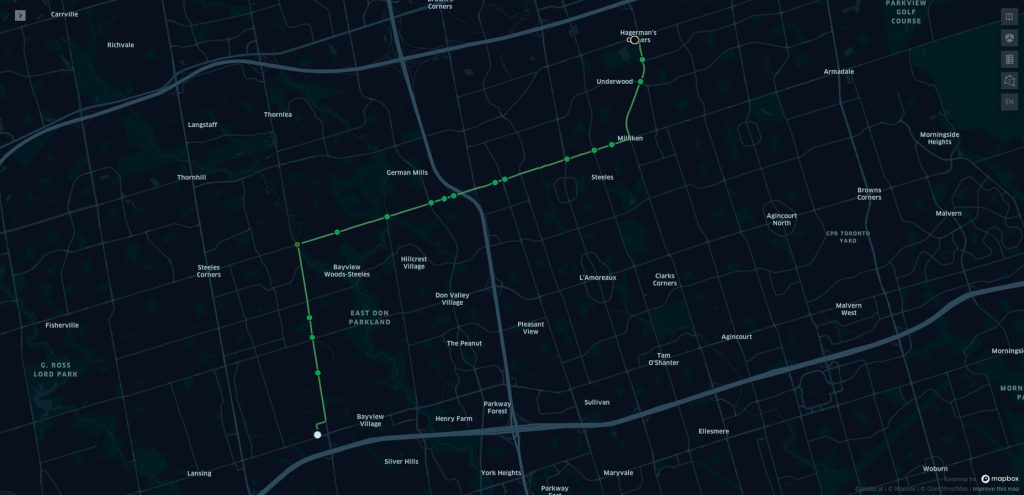
Complete trip – overlaying the path of the trip
A Start GPS event qualifies as a true Start trip event if any one of the following criteria are met:
- The previous event was an On event
- The previous event was a Stop event that occurred more than 200 seconds ago
A Stop GPS event qualifies as a true Stop trip event if any one of the following criteria are met:
- The next event is an Off event
- The next event is a Start event that occurs more than 200 seconds later
Each pair of qualifying Start and Stop events are combined to define a trip. It is straightforward to then define basic metrics such as distance traveled in the trip as well as the duration of that trip. With a well defined start and stop to the trip, other important statistics can then be calculated from the raw GPS points, such as the time the vehicle spends at different speeds throughout that trip, as well as idling durations.
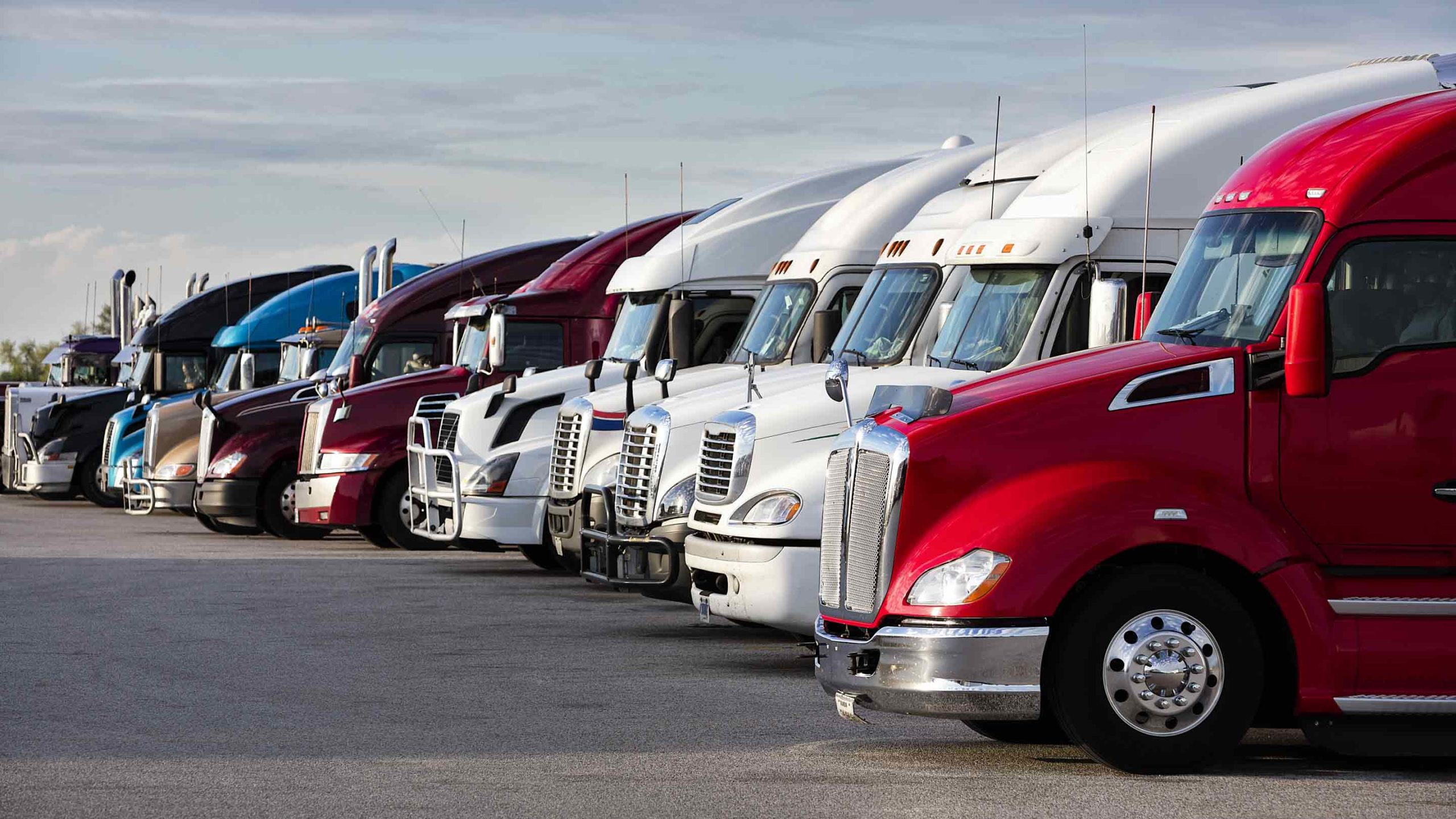
Trips in action
Transportation engineers and planners often are not only interested in the trips a vehicle takes, but also on a vehicle’s ultimate origin and destination. Consider the case of a long-haul truck’s journey from a supply depot to its ultimate destination. This journey could consist of several trips related to the truck’s operation, such as weighing stations, refueling or rest stops. Due to the careful construction of trips, we are able to flexibly “chain” trips together to determine a vehicle’s ultimate origin and destination using post-trip stop information. This is useful information when looking at border crossings, as well as when vehicles move to and from ports.
For many commercial logistical efficiencies, understanding where a vehicle is coming from and what their final destination is helps to keep freight moving at the right pace. Considering the consequences witnessed with multiple disruptions in the supply chain, using trip data along with origin and destination information can aid in investigating delays and their impacts on truck congestion at ports.
Combining trip information with vehicle industry data can also help planners gain a better understanding of which industries are contributing the most to freight traffic overall. Taking a year-over-year approach, planners can then see where the biggest increases were identified in traffic volume.
Getting granular into a vehicle’s purpose, armed also with trip and journey data can also help start to fill in gaps for transportation planners when it comes to understanding vehicle behavior. For example, identifying vehicles used in door-to-door delivery services and then being able to hone in on their trip behavior can highlight infrastructure adjustments that might be necessary to accommodate, like curbside parking.
Origin and destination and “trip chaining” information provides a new level of data-driven insights to planners for those critical infrastructure planning and transportation funding decisions.
Journey to understanding
The trips algorithm constructs flexible and meaningful trips, allowing customers to analyze their vehicle behavior and derive actionable insights from the data collected. Vehicle trips become the building blocks for the deep aggregated data insights that the Altitude platform unlocks.
With the Origin & Destination toolset in Altitude, aggregated vehicle journeys are explained with additional understanding of commercial traffic patterns, frequently used routes and other trip characteristics like bottlenecks or vehicle vocation. This level of insight drives more informed decision-making for freight activity as planners have access to view how exactly goods move on their road networks and between borders.
For more information on how Altitude’s Origin & Destination product can provide comprehensive insights into vehicle trips, visit our Origin & Destination page.

Acknowledgements
The author would like to thank Philip Mar, DataOps Developer – Data and Analytics, Jeff Bruce, Senior Software Developer, Machine Learning – Data and Analytics, and Shweta Shah, AVP – Data And Analytics, for their valuable contributions and expertise provided during the development of this white paper.
Author: Nicki Schill, Marketing Manager, Public Sector Communications
About Altitude by Geotab
With access to one of the world’s largest organically grown transportation datasets, Altitude by Geotab aggregates data from tens of millions of connected vehicles to produce actionable transportation insights and urban analytics for transportation leaders across the United States and Canada.
These insights are driven from privacy-by-design principles and are provided through the Altitude Platform, a secure, modular, open transportation analytics platform that enables partners and customers to quickly interact with the data and integrate it into internal systems, processes and workflows.
© 2022 Geotab Inc. All rights reserved.


